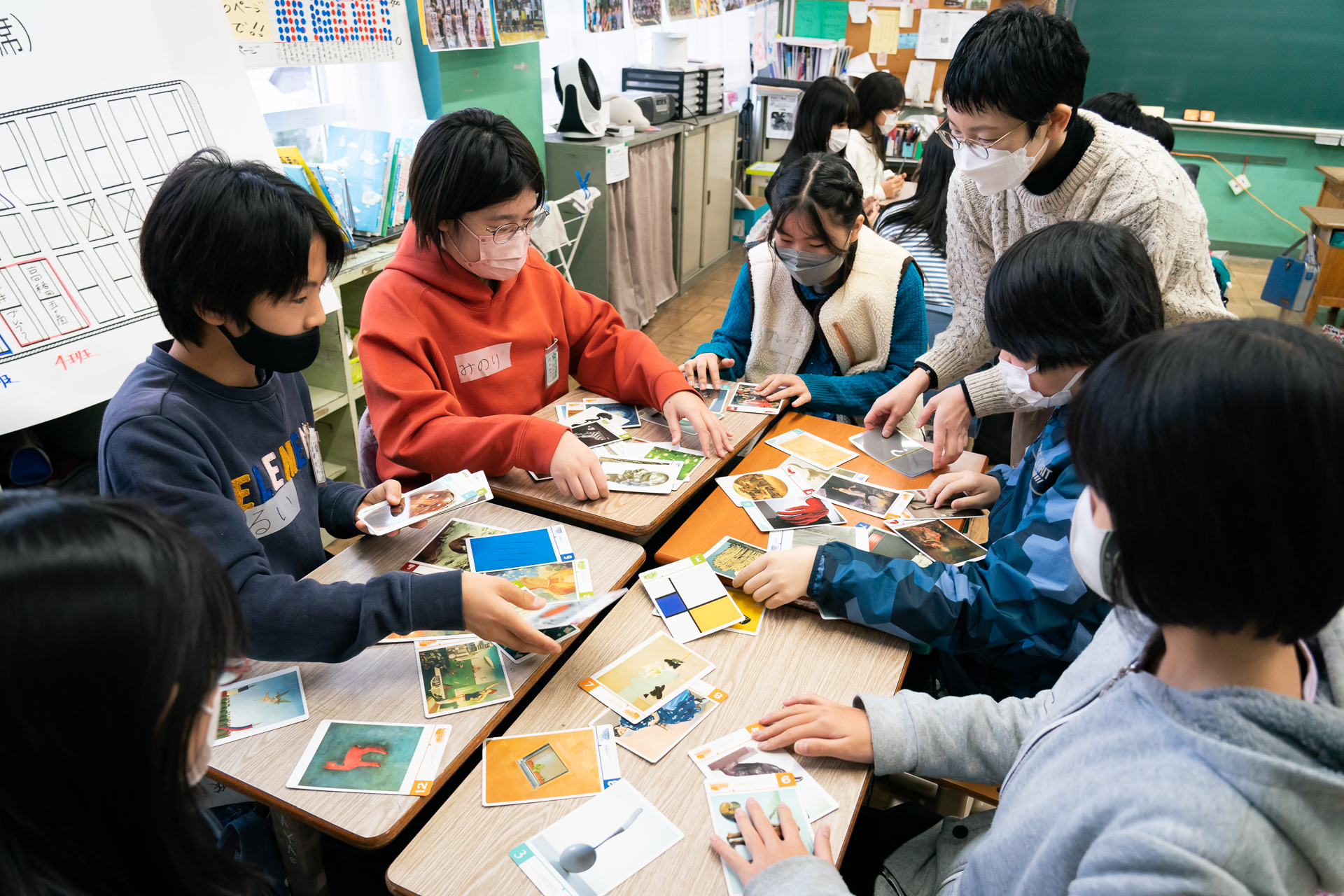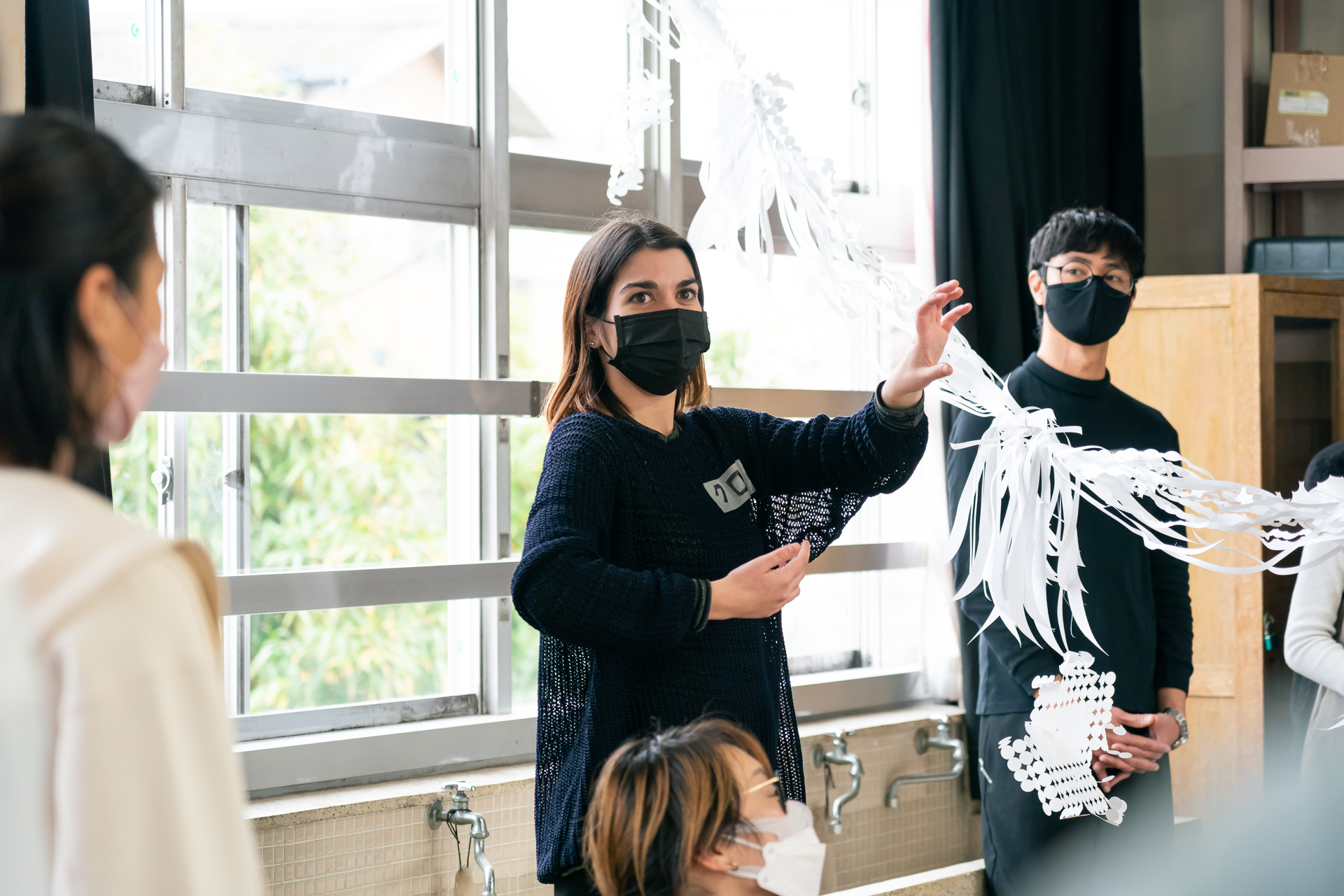Creating Space for Diversity Through Art:
Immigration Museum Tokyo’s Art Education Program 2022
Text=Dan Dagondon
(Student Staff, Immigration Museum Tokyo)

Immigration Museum Tokyo (IMM Tokyo), through its Art Education Program, conducted workshops that aimed to develop awareness and understanding of cultural diversity through art. The program ran from November 2022 to January 2023 in four different elementary schools in Tokyo’s Adachi City.
Adachi City had a significant number of foreign residents among the 23 wards of Tokyo. With the increasing number of residents with roots overseas in the area, IMM Tokyo organized a multi-layered art experience designed to touch on some aspects of multiculturalism in the community. It brought participants with diverse backgrounds including the students and teachers of participating schools, the staff of IMM Tokyo, the citizen researchers from IMM Neighbors, the representatives of the local government of Adachi City, the art communicators, and the artists with overseas roots to explore and enjoy a co-creative form of art together.
In the months leading up to the program’s launch, IMM Tokyo developed the workshops through several consultations with the schools, the local government of Adachi City, the art communicators, and the artists to create an experience that not only promotes learning but also creates new connections and meaningful interactions among the participants—a space for diversity through art.
In general, the program is designed for 5th and 6th-grade elementary school students and is consisted of 4 activities that focused on diverse ways of seeing, thinking, expressing, and artmaking. This included (1) an introductory workshop using the body as a medium of creative expression, (2) a dialogue-based artwork appreciation led by art communicators, (3) an art workshop facilitated by artists with roots overseas, and (4) a reflection workshop incorporating the whole experience. These activities were carried out flexibly in coordination with the participating schools with some only implementing activities 2 and 3.
Introductory Workshop: Diversity of Imagination and Body Expression

Naoko Ito, an IMM Tokyo staff and IMM Neighbors member, opened the program by introducing what IMM Tokyo is. The organization’s introduction opened up unique possibilities other than what is usually known to or experienced by the students; as IMM Tokyo, despite being called a museum, doesn’t have an actual building. Rather than visiting a typical museum, the students were introduced to the concept of placemaking as the program transformed their school into a museum—bringing in artworks, artists, and art experiences right into their classrooms. During the introduction, members of IMM Tokyo greeted the students in languages each of them can speak and shared some facts about their roots and background as well.

To stimulate the participants’ curiosity about cultural diversity, I, a performance maker from the Philippines, facilitated an introductory workshop that explored diverse ways of imagining common things and expressing them through the body. Through a simple narrative of discovering both living and nonliving things found in familiar places like gardens and houses, the participants playfully transformed their heads, arms, and legs into parts of these objects. They observed how the same objects can be imagined and shown in diverse ways—how plants can grow in various sizes; how mochi or rice cakes, while typically round, can be molded into desired shapes; and how a reimagined musical instrument can playfully produce amusingly different sounds. These performative explorations provided the participants an opportunity to realize the validity of all expressions as motivated by the diverse backgrounds and experiences everyone has.
Dialogue-based Artwork Appreciation: Diversity of Thought

The second activity was a dialogue-based artwork appreciation led by art communicators. Through a guided discussion that focused on pragmatic visual analysis, the participants openly discussed their thoughts about specific artworks as they saw them through their eyes. While looking at artworks and through conversational exchanges with the art communicators and with each other, this activity gave the participants a chance to think, communicate, and understand each other’s ideas and perspectives.
Furthermore, instead of focusing on a more specialized knowledge-centered way of looking, this activity broadened the participant’s appreciation of artworks by bringing their perspective to the more familiar sensorial experience and allowed them to answer questions like, what sounds can you hear, or odor can you smell within this artwork, as an example. The students were able to come up with possible characters, happenings, feelings, and narratives that they can imagine through the artworks.

Finally, the students further applied this new way of appreciating artworks when they viewed the installation done by the artist with overseas roots exhibited right within their school. Without prior information about the concept of the work and the background of the artist yet, the participants already thought about the diverse possibilities the artwork may have.
Artist’s Workshop: Diversity of Narratives
The workshop facilitated by the artists with roots overseas primarily aimed to provide a fun and engaging experience to learn about cultural diversity through art. The activity, through the mediation of the artworks made by the artists, was designed to allow the students to directly interact with the artists, the IMM staff members, the IMM Neighbors, the art communicators, the schoolteachers, and the Adachi City personnel.
In general, the workshops started with the introduction of the artists’ background and their art practice. In turn, the students were invited to share their own thoughts, ideas, and stories by creating their own art pieces using the artists’ medium. These individual art pieces were then freely installed by the participants themselves in the exhibition/workshop space establishing connections not only with the artists’ work but with each other’s narratives and creations.
Two artists with roots overseas served as facilitators for this workshop.


Chloe Paré is an artist and researcher from Greece who explores the materiality and intra-activity of visual arts through workshops, installations, and art books. Through the installation and workshop entitled, Silver Streaming System 銀河系(Gingakei), she shared various narratives about galaxy formation and then encouraged the participants to share their own galaxy creation story by constructing their own star using a paper designed to be transformable. The individual stars were then freely installed in the space allowing alterations from the participants. This process fostered a space where the participants thought about their own narratives and communicated them with others thus forming new connections which were materialized through the collective galaxy installation.


Sepideh Hashemi is an Iranian artist based in Japan who explores practices related to photography. She is also interested in the influence of bodies in artists’ works such as self-portraits. In her workshop, she invited the participants to write their own messages of sympathy or thoughts about wars and conflicts that are currently happening in various parts of the world. As means of respecting the participants’ free will, she encouraged them to write on everyday objects like receipts, wraps, packaging, and pieces of paper that can be found either in their bags or pockets. These messages are then hung together with her installation both as a means to share inspiration and as a collective call to attention to the conflicts happening in the world.
In both workshops, the classrooms were transformed not just by the artists’ installation but by the co-creative process of the workshop that encouraged the participants to freely express through their individual artwork creation and to exchange narratives through dialogue or actions during their installation. The exhibition venue became not only a place where the artists showed the objects produced by their respective practice but a space that allowed the formation of new connections. The altered artwork installation is the materialization of the intangible connections the participants have shared. These new connections established an initial germination space to understand cultural diversity from multiple perspectives.
Reflection Workshop: The Diverse Ways We Remember

The final activity for this program was a reflection workshop facilitated by IMM Tokyo staff, Kaede Kimura. She designed a paper where students can reflect on their experiences by either writing words, drawing figures, or coloring parts of the paper. While still using a creative technique that encourages free expression, the students can discover new aspects of themselves. Also, by looking at each other’s final creations, they worked their way through their classmates’ varied modes of remembering—what they saw, felt, understood, and expressed.
Author’s Notes on Creating Spaces for Diversity
Each activity in IMM Tokyo’s Art Education Program focused on creating an environment where participants are encouraged to express their thoughts while interacting with each other, hence, establishing meaningful connections. Without directly discussing concepts about cultural diversity, the space that the workshops created allowed the actual and more natural intermingling of diverse bodies, thoughts, experiences, and narratives.

Moreover, working on this program as an IMM Tokyo staff member, an Adachi City resident, a workshop facilitator, and an artist with roots overseas allowed me to think and reflect on diversity and multiculturalism in multiple layers. Having been able to connect and interact with different members of the community, from the schools’ students and teachers, the local government representatives, the IMM Neighbors, and fellow IMM Tokyo staff, I heard firsthand how each one thinks about diversity, how each one sees their role in a multicultural community, and how each one works towards the objective of understanding it. Just like the workshops in the Art Education Program, I also felt the sense of a community working and creating together regardless of our differences in languages, roots, and background.

